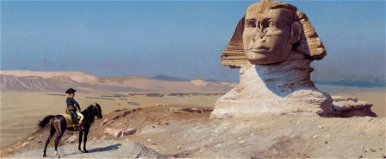When we say Egypt, most people immediately think of two things: Pyramids And the Sphinx. Both are surrounded by many secrets and mysteries – some of which may never be solved – but scientists seem to be discovering new and interesting things about the pyramids. However, the Sphinx is also full of mystery, and moreover, it is little talked and written about, so many people do not even get the shocking information and disappointing facts that are revealed about it.
The cutting-edge technology that helped build the Egyptian pyramids was found in the Nile River
Read more…
Read more…
Since everything we know about the Great Sphinx is a thousand-year-old lie, practically nothing we have learned about it either in life or in history lessons is true. This has already been highlighted by scholars and historians themselves, and now we have collected the lies we have known so far and the corresponding facts.
The name of the Sphinx is the Sphinx – and it's not even close
The ancient Egyptians never called this statue the Sphinx – there is a reference to it, for example, in a dream painting written in 1400 BC. When the fourth. Pharaoh Thermos was sleeping next to the Sphinx, and the sun god appeared to him in a dream and told him that if he cleaned the sand from the Sphinx's feet, he could become the ruler. For this reason, the Great Sphinx was called the Horus of the Horizon, and the Arabs in the Middle Ages later called it the Flame. The name Sphinx itself was used only in the Greek and Roman eras, because it closely resembles the winged sphinx with the head of a woman and the body of a lion known in Greek mythology. Greek writers gave it this name for this reason – although the Egyptian Sphinx has a male face and does not have wings.
The color is not right either
Although everyone in the world knows the sand-colored Sphinx, this was not always the case. It was colorful too. When archaeologist Mark Lehner conducted tests on the surface of the statue, they found remnants of colored pigments on it, from which they concluded that the face of the Sphinx was probably red, and the rest was yellow and blue.
Wasn't it made for the Sphinx?
Scholars debate this matter, but many say that the Sphinx was not originally intended to be a sphinx, but rather was intended to depict one of the Egyptian pharaohs. It is believed that the reason behind this is why it was placed directly next to a large pyramid, if that was not the way they wanted to honor the ruler who was buried in that pyramid. According to some scholars, the statue bears the facial features of Pharaoh Hafri.
It's also a good question, by the way, what the Great Sphinx is looking at. Here is an interesting video on this topic:
It is built from several layers
Many people live under the misconception that the Great Sphinx was built from the same shape of stones as the pyramids themselves, although this is not true. The statue was actually carved from a single massive stone, but appears to have been assembled from several layers.
He was bearded
Not only does the Sphinx have no nose, it also has no beard – however, it has long been thought to have been absent originally. According to Egyptologist Vasil Dobrev, the statue had a beard, and the missing piece is now preserved in the British Museum. But it is possible that the beard was not formed on the statue itself, as there are no clear signs of it on the chin. Therefore, scholars believe that the beard was added to the Sphinx at a later time.
In addition to all this, there is the famous nose question: What is the reason for the broken nose of the Sphinx? Most people think so Napoleon Bonaparte He was shot, although 15th-century paintings depict the statue without a nose, when Napoleon had no idea. You can read about this fact in our other article:

This is why the Great Sphinx of Giza does not have a nose. Napoleon is just a scapegoat in the story of the mutilated Egyptian statue.
Read more…
Read more…
(source: Stady)












































